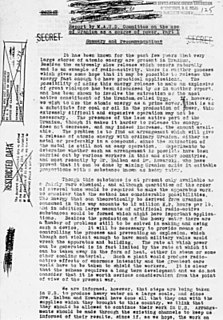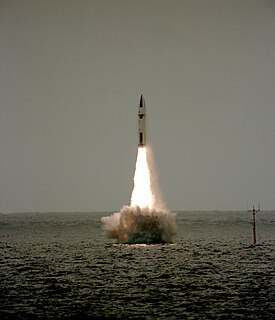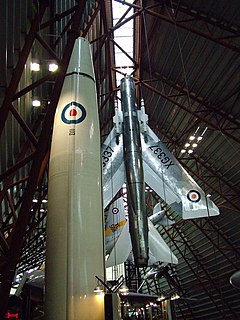 W
WIn 1952, the United Kingdom became the third country to develop and test nuclear weapons, and is one of the five nuclear-weapon states under the Treaty on the Non-Proliferation of Nuclear Weapons.
 W
WThe 1958 US–UK Mutual Defense Agreement, or UK–US Mutual Defence Agreement, is a bilateral treaty between the United States and the United Kingdom on nuclear weapons co-operation. The treaty's full name is Agreement between the Government of the United States of America and the Government of the United Kingdom of Great Britain and Northern Ireland for Cooperation on the uses of Atomic Energy for Mutual Defense Purposes. It allows the US and the UK to exchange nuclear materials, technology and information. The US has nuclear co-operation agreements with other countries, including France and other NATO countries, but this agreement is by far the most comprehensive. Because of the agreement's strategic value to Britain,, Harold Macmillan called it "the Great Prize".
 W
WIn nuclear physics, the Bateman equation is a mathematical model describing abundances and activities in a decay chain as a function of time, based on the decay rates and initial abundances. The model was formulated by Ernest Rutherford in 1905 and the analytical solution was provided by Harry Bateman in 1910.
 W
WBritain contributed to the Manhattan Project by helping initiate the effort to build the first atomic bombs in the United States during World War II, and helped carry it through to completion in August 1945 by supplying crucial expertise. Following the discovery of nuclear fission in uranium, scientists Rudolf Peierls and Otto Frisch at the University of Birmingham calculated, in March 1940, that the critical mass of a metallic sphere of pure uranium-235 was as little as 1 to 10 kilograms, and would explode with the power of thousands of tons of dynamite. The Frisch–Peierls memorandum prompted Britain to create an atomic bomb project, known as Tube Alloys. Mark Oliphant, an Australian physicist working in Britain, was instrumental in making the results of the British MAUD Report known in the United States in 1941 by a visit in person. Initially the British project was larger and more advanced, but after the United States entered the war, the American project soon outstripped and dwarfed its British counterpart. The British government then decided to shelve its own nuclear ambitions, and participate in the American project.
 W
WThe British hydrogen bomb programme was the ultimately successful British effort to develop hydrogen bombs between 1952 and 1958. During the early part of the Second World War, Britain had a nuclear weapons project, codenamed Tube Alloys. At the Quebec Conference in August 1943, British prime minister Winston Churchill and United States president Franklin Roosevelt signed the Quebec Agreement, merging Tube Alloys into the American Manhattan Project, in which many of Britain's top scientists participated. The British government trusted that America would share nuclear technology, which it considered to be a joint discovery, but the United States Atomic Energy Act of 1946 ended technical cooperation. Fearing a resurgence of American isolationism, and the loss of Britain's great power status, the British government resumed its own development effort, which was codenamed "High Explosive Research".
 W
WThe Frisch–Peierls memorandum was the first technical exposition of a practical nuclear weapon. It was written by expatriate German physicists Otto Frisch and Rudolf Peierls in March 1940 while they were both working for Mark Oliphant at the University of Birmingham in Britain during World War II.
 W
WThe Gen 75 Committee was a committee of the British cabinet, convened by the Prime Minister, Clement Attlee, on 10 August 1945. It was one of many ad hoc cabinet committees, each of which was convened to handle a single issue, and given a prefix of Gen and a number. The purpose of the Gen 75 committee was to discuss and establish the British government's nuclear policy. Attlee dubbed it the "Atom Bomb Committee". It was replaced by an official ministerial committee, the Atomic Energy Committee, in February 1947.
 W
WHigh Explosive Research ("HER") was the British project to develop atomic bombs independently after the Second World War. This decision was taken by a cabinet sub-committee on 8 January 1947, in response to apprehension of an American return to isolationism, fears that Britain might lose its great power status, and the actions by the United States to withdraw unilaterally from sharing of nuclear technology under the 1943 Quebec Agreement. The decision was publicly announced in the House of Commons on 12 May 1948.
 W
WThe MAUD Committee was a British scientific working group formed during the Second World War. It was established to perform the research required to determine if an atomic bomb was feasible. The name MAUD came from a strange line in a telegram from Danish physicist Niels Bohr referring to his housekeeper, Maud Ray.
 W
WThe Montreal Laboratory in Montreal, Quebec, Canada, was established by the National Research Council of Canada during World War II to undertake nuclear research in collaboration with the United Kingdom, and to absorb some of the scientists and work of the Tube Alloys nuclear project in Britain. It became part of the Manhattan Project, and designed and built some of the world's first nuclear reactors.
 W
WThe Nassau Agreement, concluded on 21 December 1962, was an agreement negotiated between President of the United States, John F. Kennedy, and Harold Macmillan, the Prime Minister of the United Kingdom, to end the Skybolt Crisis. A series of meetings between the two leaders over three days in the Bahamas followed Kennedy's announcement of his intention to cancel the Skybolt air-launched ballistic missile project. The US agreed to supply the UK with Polaris submarine-launched ballistic missiles for the UK Polaris programme.
 W
WThe United Kingdom's Polaris programme, officially named the British Naval Ballistic Missile System, provided its first submarine-based nuclear weapons system. Polaris was in service from 1968 to 1996.
 W
WThe Polaris Sales Agreement was a treaty between the United States and the United Kingdom which began the UK Polaris programme. The agreement was signed on 6 April 1963. It formally arranged the terms and conditions under which the Polaris missile system was provided to the United Kingdom.
 W
WProject E was a joint project between the United States and the United Kingdom during the Cold War to provide nuclear weapons to the Royal Air Force (RAF) until sufficient British nuclear weapons became available. It was subsequently expanded to provide similar arrangements for the British Army of the Rhine. A maritime version of Project E known as Project N provided nuclear depth bombs used by the RAF Coastal Command.
 W
WProject Emily was the deployment of American-built Thor intermediate-range ballistic missiles (IRBMs) in the United Kingdom between 1959 and 1963. Royal Air Force (RAF) Bomber Command operated 60 Thor missiles, dispersed to 20 RAF air stations, as part of the British nuclear deterrent.
 W
WThe Quebec Agreement was a secret agreement between the United Kingdom and the United States outlining the terms for the coordinated development of the science and engineering related to nuclear energy and specifically nuclear weapons. It was signed by Winston Churchill and Franklin D. Roosevelt on 19 August 1943, during World War II, at the First Quebec Conference in Quebec City, Canada.
 W
WTrident, also known as the Trident nuclear programme or Trident nuclear deterrent, covers the development, procurement and operation of nuclear weapons in the United Kingdom and their means of delivery. Its purpose as stated by the Ministry of Defence is to "deter the most extreme threats to our national security and way of life, which cannot be done by other means". Trident is an operational system of four Vanguard-class submarines armed with Trident II D-5 ballistic missiles, able to deliver thermonuclear warheads from multiple independently targetable re-entry vehicles (MIRVs). It is operated by the Royal Navy and based at Clyde Naval Base on the west coast of Scotland. At least one submarine is always on patrol to provide a continuous at-sea capability. Each one carries up to eight missiles and forty warheads, although their capacity is higher. The missiles are manufactured in the United States, while the warheads are British.
 W
WTube Alloys was the code name of the research and development programme authorised by the United Kingdom, with participation from Canada, to develop nuclear weapons during the Second World War. Starting before the Manhattan Project in the United States, the British efforts were kept classified, and as such had to be referred to by code even within the highest circles of government.
 W
WThe "V bombers" were the Royal Air Force (RAF) aircraft during the 1950s and 1960s that comprised the United Kingdom's strategic nuclear strike force known officially as the V force or Bomber Command Main Force. The three models of strategic bomber, known collectively as the V class, were the Vickers Valiant, which first flew in 1951 and entered service in 1955; the Avro Vulcan, which first flew in 1952 and entered service in 1956; and the Handley Page Victor, which first flew in 1952 and entered service in 1957. The V Bomber force reached its peak in June 1964 with 50 Valiants, 70 Vulcans and 39 Victors in service.